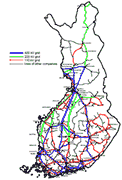National Energy Grid
|
 |
|
Full Size Map National Electricity Transmission Grid of Finland(15 kb) |
GRID SUMMARY
Finland, with per capita electricity consumption of about 15,000 kilowatthours (Kwh) in 2000, was among the highest in the world (U.S. was about 10 thousand kilowatt hours.) This is attributed to the extreme winter temperatures, a high degree of industrialization, a relative preponderance of energy intensive industries (i.e., timber, paper, pulp), and a high standard of living. All fuel for thermal electric power plants must be imported, although Finland has attempted to diversify by emphasizing the use of nuclear, hydroelectric, wind, and biomass.
In 2001, total Finnish power generating capacity was 16.2 million kilowatthours. Of this, more than half was oil and natural-gas fired, with 18% hydroelectric, 16% nuclear, around 13% coal (mainly combined heat and power), and 0.2% "other" renewables (wind, solar, biomass, etc.). Finland reportedly is looking to move away from coal for environmental reasons, but currently, there is relatively little investment in renewable energy sources besides wood-based biofuels. Also, in June 2003, plans to build a major new hydro plant in Lapland were shelved due to environmental opposition, increasing calls for the country to build more nuclear power instead.
Finland’s electric transmission company, Fingrid, is integrated with the Nordic electricity spot market Nordpool, allowing for significant electricity imports, mainly from Sweden. In addition, Finland imports a small amount of electricity from Norway and exports small amounts of electricity to both of those countries. Finland also has an interconnection capacity with Russia, and is expected to import 10 Bkwh in 2003, up from 7.8 Bkwh in 2002. Overall, total Finnish electricity consumption was about 76.2 Bkwh in 2001, of which about 15% was imported. In December 2002, Russian utility Kolenergo reportedly signed a deal to export 650 megawatthours of power to Finland and Norway. Overall, Finland would like to diversify its power sources and reduce its reliance on any one supplier, like Russia.
In April 2003, power companies from Estonia, Latvia, and Finland signed an agreement on laying an 315-MW underwater power cable linking Finland and Estonia. The line, known as "Estlink," is expected to cost $117 million and to be ready by 2005. Estlink should enable better electricity integration of the Baltics and Nordic region. In January 2003, Fortum announced that it was buying a 45% share in Tartu Energy, Estonia's regional heat producer, with the rights to purchase a majority stake in the company during 2004.
ENERGY SUMMARY : FINLAND
Map
of Finnish Electricity Grid | National Energy Grid Index
GENI Home Page | Contact
GENI | Subscribe
to GENI Newsletter | Pledge
| Comments
| GENI Forum
Email this page to a friend
If you speak another language fluently and you liked this page, make
a contribution by translating
it! For additional translations check out FreeTranslation.com
(Voor vertaling van Engels tot Nederlands)
(For oversettelse fra Engelsk til Norsk)
(Для дополнительных
переводов проверяют
FreeTranslation.com )

